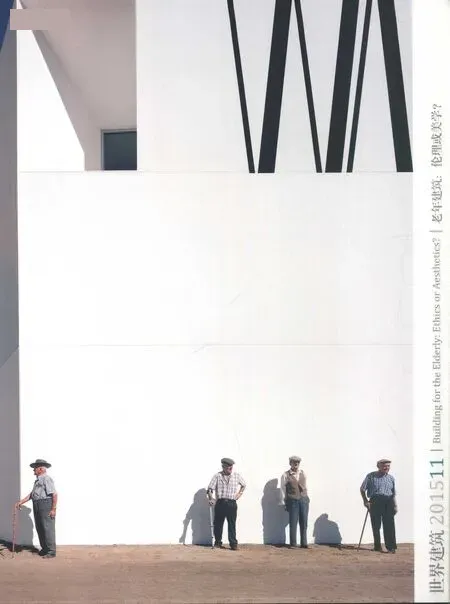圣卡洛鲁斯老年人之家,弗莱堡,德国
建筑设计:PEG mbH
圣卡洛鲁斯老年人之家,弗莱堡,德国
St. Carolushaus,Freiburg,Germany,2012
建筑设计:PEG mbH
Architects: PEG mbH
人口增长已经成为影响社会经济政治的最大难题之一,随着人口寿命的增长,老龄化对社会和医疗保障政策的影响越来越明显。针对不再适宜单独居住和患病需要照料的老年人,将传统的“居家养老”观念向“机构养老”转变,以及怎样才能改善其所在养老机构的生活质量,成为一个急需考虑的问题。新圣卡洛鲁斯老年人之家就是在这样的背景下重新设计和建造的。
历史背景
1903年弗莱堡圣文森·冯·保罗慈善修女教会(Orden der Bermherzigen Schwestern vom hl. Vinzenz von Paul)就为退休老人和圣约瑟夫医院的老年康复者建造了圣卡洛鲁斯老年人之家。为了适应现代护理理念所需的建筑层面,决定新建圣卡洛鲁斯老年人之家,地点在旧址对面,新旧建筑可同时使用。
设计理念
建筑师在原有建筑层面进行新的建筑形态,设计并建造被称为“第五代”的老年人之家。通过形体、色彩、材料、采光的合理运用来创造空间,并兼顾居住者、工作人员、亲属和访客的需求。圣卡洛鲁斯从传统的集中照料护理结构中分离出来,提供自给自足的共同居住模式。通过一个连接体把两个分别独立的建筑体相连接。
根据城市设计对地块的限定,共7层的新圣卡洛鲁斯老年人之家(包括地下车库和6层地上部分)须在哈布斯布格尔大街退让,并且在没有相邻建筑的多伊朔登大街路口作出“收口”处理,与对街建筑共同形成清晰的街道入口。主入口位于建筑物的中间的哈布斯布格尔大街。
首层包括办公区、多功能厅、公共浴间、修女居住区域及相关附属功能,并设有无障碍出入口。圆形的祈祷室成为穆特豪斯教堂和老年之家的枢纽。
入口处设有玄关,带有独立卫浴的房间围绕着中央的餐厅展开。过道、活动室和房间通过日光形成很好的空间导向性。所有的附属和服务空间均位于两个居住区域中间的连接体上。
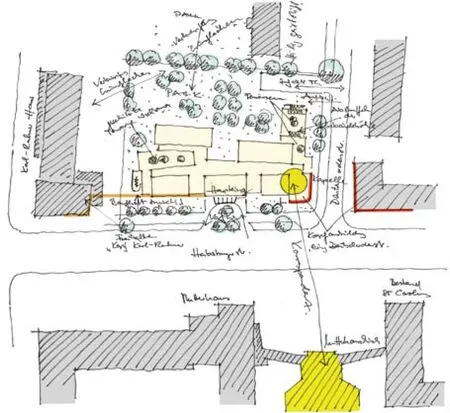
1 手绘总平面图/Sketch,layout of St. Carolushaus
共同居住理念:在关怀和照料下共同生活
新圣卡洛鲁斯老年人之家的投资方为弗莱堡圣文森·冯·保罗慈善修女教会,共有115个全托床位,分布在8个小居住单元里(每个单元10~13位居住者),其中15个床位专供受脑部创伤者使用。项目从设计到后期施工均由德国PEG设计事务所独立完成。项目总使用面积为8515m2,总规划使用面积为12,700m2。
设计理念放弃传统的集中模式,采用分散地组织工作流程。将被看护的个人融入到日常生活当中,不再突显看护个人是身体上需要被照料的个体。小规模的居住单元可以增进居住者彼此之间的亲密度与相处的舒适度。
共同居住的核心理念是:(1)正常化原则——即作为对老年人日常活动计划制订和他们社交活动的核心元素,目的是让行动不便的老年人也可以参与到一系列与生活相关的活动中。(2)环境辨识度——环境辨识度可以使对物体和辅助设备的导向变强。房间具有大面积的开窗面积,配有独立的浴室,并围绕着活动室展开布置以更好地实现“居家化”模式。(3)在建造的过程中,设计特别注意利用采光,节能感应灯具以及利用色彩营造的舒适氛围。
以人为本是其突出的设计理念,即受照料的居住者作为个体会尽自己的能力接受自己的不便,这就是圣卡洛鲁斯老年之家给需要者提供的不一样的地方。
随着新圣卡洛鲁斯老年人之家的建造,它将承担起个人化、教会化的新一代的老年人看护任务。
项目信息Credits and Data
客户/Client: 弗莱堡圣文森·冯·保罗慈善修女教会/Orden der Bermherzigen Schwestern vom hl. Vinzenz von Paul
主持建筑师/Principal Architect: Peter Schmieg
设计团队/Design Team: PEG mbH
承建方/Construction: PEG mbH
工程总造价/Cost: Approx. 22.000.000 EU
材料/Materials: 钢筋混凝土/Reinforced concrete
场地面积/Site Area: Approx. 9270m2
建筑面积/Floor Area: Approx. 7740m2
设计时间/Design Period: 2009
建造时间/Construction Period: 2010
摄影/Photos: Orden der Bamherzigen Schwestern Freiburg/ Peter Schmieg
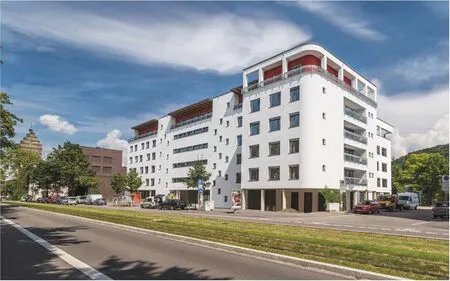
2 外景/Exterior view
Population growth has become one of the challenges influencing society,economy and politics. Along with the growing life-span of human beings,ageing has an increasingly obvious impact on society and medical security policies. With regard to the elderly who are not able to live alone and who need care because of illnesses,it is an urgent issue to transfer our idea from "home-based care" to "institution-based care",and to improve the life quality for the aged living in nursing institutions. St. Carolushaus,a home for the aged,is redesigned and reconstructed in this context.
Context
In 1903,St. Carolushaus was built for retired old people and old rehabilitees in the Hospital of St.Josefkrankenhaus by Order of the Sisters of Charity of St. Vincent de Paul Fribourg (Orden der Bermherzigen Schwestern vom hl. Vinzenz von Paul). To meet the architectural requirements for the idea of modern nursing,a new St. Carolushaus will be built on a site opposite the old building,and the new and old buildings can be used at the same time.
Design idea
Architects create a new architectural pattern on the basis of the original building and design and build a "fifth-generation" home for the aged. Shapes,colors,materials and lighting are properly adopted to create spaces to meet the needs of residents,staff,relatives and visitors. St. Carolushaus is separated from the traditional concentrated nursing structure and provides a self-sufficient joint habitation mode. The two separate buildings are connected by a connector.
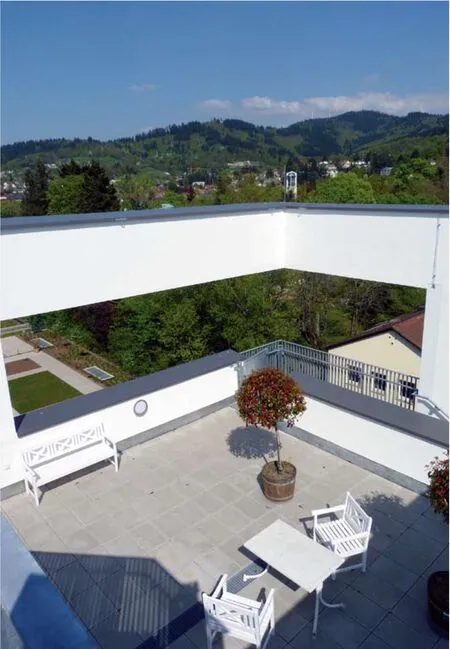
3 屋顶平台/Roof terrace
Limited by the planning for parcels of land in urban design,the new seven-floor St. Carolushaus has to back down in the Habsburger Street and "close up" at the junction of Deutschorden Street with no adjoining buildings,forming a distinct street entrance together with buildings on the opposite side. The main entrance is located in Habsburger Street in the middle of the building.
The first floor includes an administrative area,a multifunctional hall,a public bathroom,a residential area for sisters and related auxiliary functional areas; it is also equipped with accessible entrances and exits. A round prayer room becomes an interchange of the Church of Mutterhaus and the St. Carolushaus.
The Rooms,each having a vestibule and a separate bathroom,are arranged around the central dinning room. Passageways,activity rooms and resident rooms are well oriented spatially by sunlight. All auxiliary spaces and service spaces are located in the connector between the two residential districts.
Idea of joint habitation: living together with solicitude and care
The new St. Carolushaus is funded by Order of the Sisters of Charity of St. Vincent de Paul Fribourg. There are 115 full-time nursing beds distributed in 8 small residential units (10~13 residents per unit),of which 15 beds are specially used for persons with brain injuries. The project,from design to construction,is completed by PEG Design. The project's overall usable floor area is 8,515m2,and the overall planned usable floor area is 12,700m2.
Traditional concentration mode is not adopted in the design; instead,the work flow is organized in a decentralized way. The nursed individuals are involved in daily life,and it no longer highlights the nursed people's sense of being cared physically. Small-scale residential units can improve familiarity among residents and comfort of living together.

4 休闲区平台/Roof terrace of leisure area
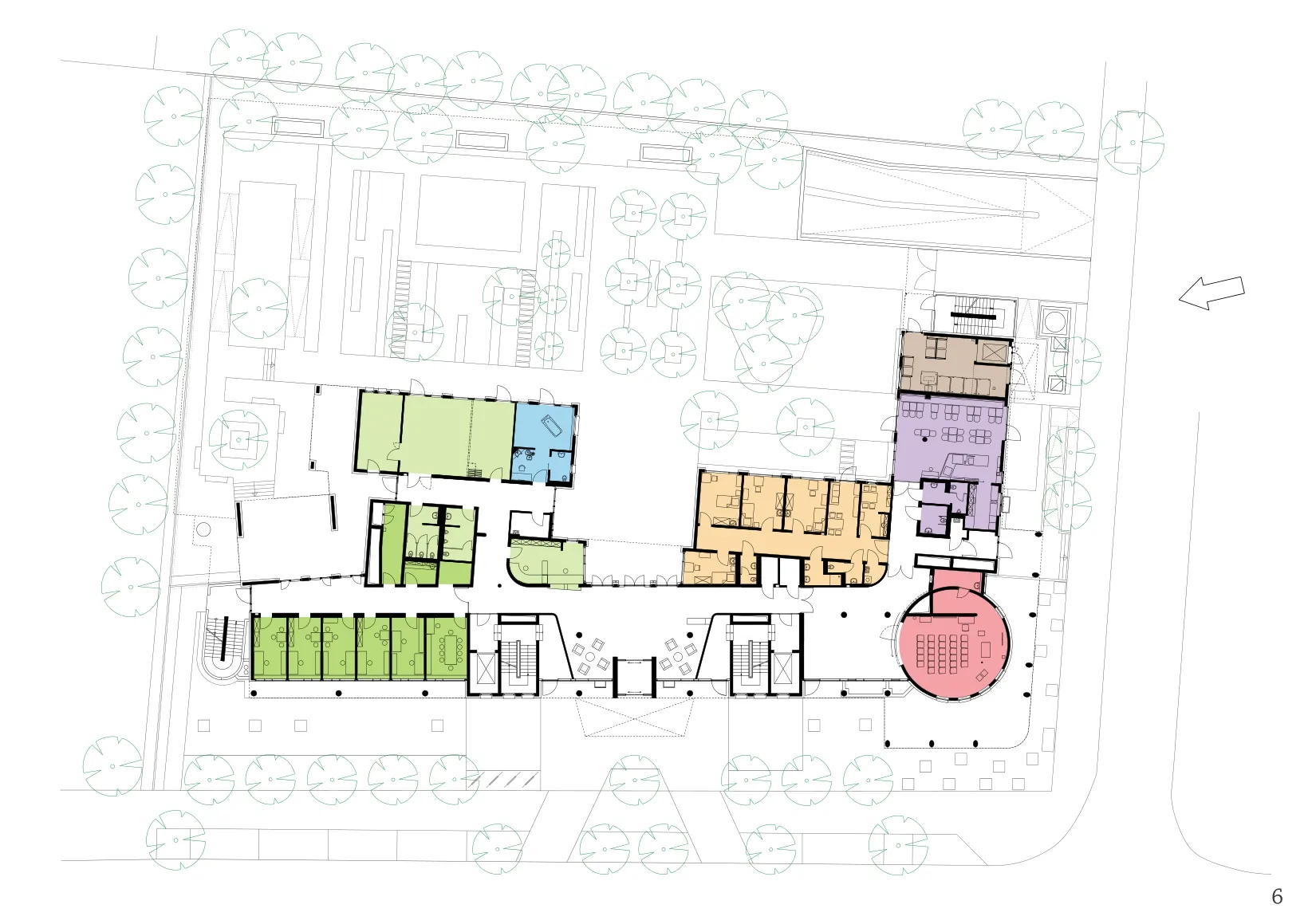
6 首层平面/Floor 0 plan
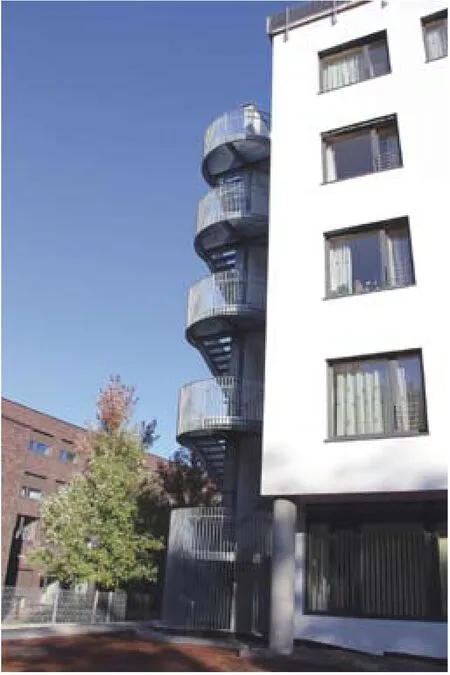
5 外观一角/A corner of facade
The core concepts of joint inhabitation are:(1) Principle of normalization - it is used as the core principle for planning of daily life activities and social activities for the elderly,so as to engage the mobility-impaired old people in a series of liferelated activities; (2) Identification degree for the environment - it can improve orientation of objects and auxiliary equipment; each room has a large window area and a separate bathroom. Rooms are arranged around activity rooms to realize a better "home-based" mode. (3) During construction,the lighting,energy-efficient induction lamps and colors are used in design to create a comfortable atmosphere.
The human-oriented design concept is adopted to make the nursed residents accept their inconveniences as possible as they can,which is the different aspect that St. Carolushaus provides for the elderly.
Along with construction of the new St. Carolushaus,it will undertake the new generation nursing task for the elderly.
评论
程晓青:这是一个非常“专业”的设计案例,无论空间组织还是平面布局,乃至细部装修均显示了设计者在老年建筑设计领域具有丰富的实践经验。然而不仅如此,方案还展现了一些新的探索,通过对“共同居住”理念的引入,作者强化了对老年人个体的尊重;组团化的布局缩小了服务单元,控制了单元的适度人数规模,有利于老年人彼此之间建立亲近的社交伙伴关系,在个体与群体的和谐中“互助养老”。
刘玉龙:圣卡洛鲁斯老年人之家采用街坊式的布局,沿袭了既有的城市街道界面,建筑不是以唯我独尊的中心式的形象出现,而是采用一种谦逊和融入的姿态介入到城市生活中,这是一栋看起来非常寻常的房子,也是对居住于此的老人生活态度的最好诠释。
内部空间也有别于一般照护型养老设施的医疗式布局方式,采用厅-室的居家布局模式,这种模式提供了很好的辨识性和安全感。建筑首层廊下和顶层的平台提供了老人和城市生活交流的舞台,可以想像,坐在平台上的椅子上看老城的黄昏对于生于斯长于斯的老人是一幅多么动人的场景。
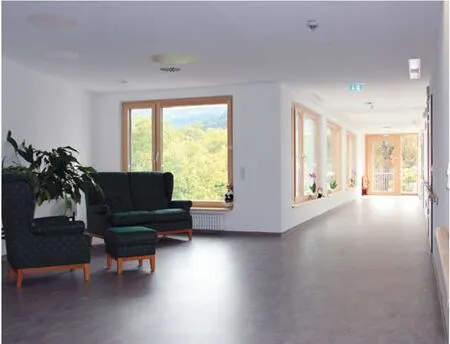
7 休息区/Resting area
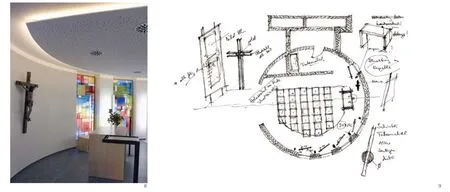
8 祈祷室内景/Interior view of oratory9 祈祷室手绘平面/Sketch plan of oratory
Comments
CHENG Xiaoqing: This is a very "professional" design case. Every aspect,be it space organization,flat layout,or even decoration details,shows that the architect has a wealth of practical experience in the field of design for the aged. Moreover,it presents some new explorations of design: by introducing the idea of "joint-habitation",the architect strengthens the respect for the individual; the cluster layout reduces the size of service units and controls each unit's occupant number at a reasonable level,which helps the elders establish a close social relationship among themselves and build a "pension community" in the harmony of individual and group.
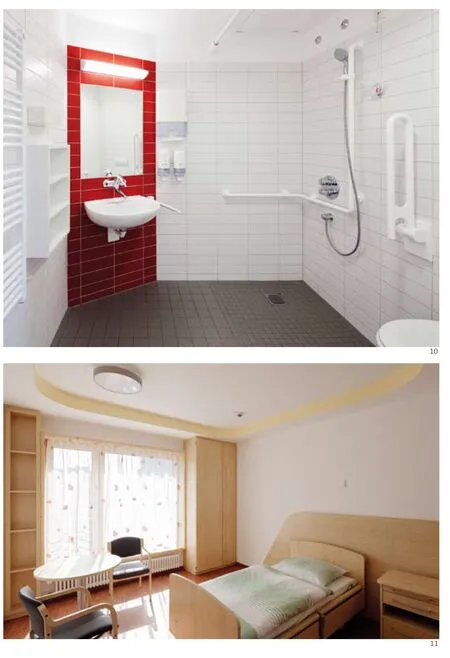
10 浴室/Bathroom11 居室/Bedroom
LIU Yulong: With its house community layout,St. Carolushaus keeps consistent with the streetscape. Instead of showing a self-centered egoism,the architecture of St. Carolushaus merges into the urban life with a modest posture. Ordinary as it appears to be,this building is at the same time a perfect metaphor of the life attitude of the elders who live there.
The interior space is also different from the hospital-like layout normally adopted in nursing facilities. A home-like layout with living room and bedroom is adopted to provide better identification and sense of security. Moreover,verandas under the porch and on the rooftop serve as platforms where the elders interact with the urban life. It is not hard to imagine how moving the scene would be when the elders sit on those verandas,watching the sunset of the old city where they grew up and lived.
——基于CFPS 2016年数据的实证分析

